The units of time
Heritage from a distant past
Often, ancient civilisations seem to have had capabilities and knowledge that are difficult to explain on the basis of the supposed scientific and technological level of their time, so that we are led to assume that they were inherited from a previous unknown civilisation, much more advanced.
For example, the existence of the renaissance maps (Piri Reis, Oronteus Finnaeus, Mercator…) with longitude accuracies considered impossible at that time, and the representation of Antarctica as it appeared at the end of Pleistocene was so inexplicable that a scientist like Charles Hapgood postulated the existence, sometime before 8,000 years ago, of an unknown civilisation able to chart the whole world with extreme precision.
But it’s not necessary to look for challenging knowledge and capabilities in order to find evidence of that kind. Indeed, knowledge and figures still currently used can provide straightforward evidence that they originated in a very distant past by an unknown civilisation whose technological level was much more advanced than that of all known ancient civilisations.
Here, we consider something apparently insignificant and devoid of any hidden meaning: the presently used unit of time, the second. It’s a unit used throughout the world which characterizes every instant of our life and is fundamental for the description of every physical phenomenon. We can hardly underestimate its importance, and yet we ignore what is the origin and the meaning of this unit that we have inherited with no indication whatsoever about the author, the epoch and the reasons that determined the choice of its magnitude.
The current opinion is that it originated from the ancient Sumerians because of their sexagesimal accounting system. In fact, 86,400 is a number clearly connected to that system, as it can be divided into 24 hours of 60 minutes, each minute consisting of 60 seconds. The same origin can be hypothesised for the convention of dividing the circle into 360 degrees, each one of 60 minutes and 60 seconds of arc.
The problem is that we don’t have the faintest idea of how and why the Sumerian sexagesimal system originated. It’s more likely, on the contrary, that it was that particular unit of time that originated such a strange, almost absurd, accounting system. And in any case, we don’t know what the magnitude of this unit of time represents. Was it a casual choice or, instead, a length of time with a meaningful connection to some particular astronomical magnitude? Was it invented by the Sumerians, or did the Sumerians inherit it from a previous civilisation, as we did from them?
The scientific definition of the second
Usually, a unit of measure is established on the basis of some significant characteristic of our planet. For example, the unit of length, the meter, has been obtained by dividing the circumference of Earth by 40,000,000, which presupposes a knowledge of its actual length.
We can reasonably expect that the unit of time, the second, also represents a magnitude somehow related to the time of Earth’s rotation around itself and around the Sun, that is of the solar day and the tropic year. And in fact, this is how the modern scientists have intended it and defined it.
The second represents the 86,400th part of the day. Which day? The length of the solar day, that is of the timespan between two successive zenithal passages of the Sun, is not a constant, due to the fact that the Earth’s speed around the sun is not constant, because of its elliptic orbit and Kepler’s laws. The second is a fraction of the “mean” solar day during a whole tropic year. Therefore, in order to establish this unit of time it is necessary to know exactly how many solar days are contained in a tropic year.
But, again, which year? The ratio between day and year is not a constant, because Earth is continually undergoing a deceleration caused by the braking action of the tides. That’s why modern scientists were forced to chose a particular date to which attach their definition of the unit of time. The definition ratified by the Eleventh General Conference on Weights and Measures in 1960 is:
“The ephemeris second is the fraction 1/31,556,925.9747 of the tropic year for year 1900 January 1 at 12 hours.”
Which means that the length of the tropic year on the 1st of January 1900, at 12 o’clock, had been previously calculated in 365.24219878125 (= 31,556,925.9747 x 86,400) solar days. Usually this number is rounded to the fourth decimal as 365.2422 .
However, this is a definition “a posteriori”, and it doesn’t say anything about the real meaning of that unit, and which was the reason for the choice of this particular magnitude, which does not seem to be related in a meaningful way to the length of the year. Whoever established that unit, instead, sometime in a very distant past, had to know a priori the exact number of solar days contained in a tropic year, and he choose its magnitude with the purpose of having a unit with a significant meaning in relation to both of them.
In other words, the value of the fundamental unit of time, the second, suggests evidence that an unknown advanced civilisation existed in a distant past, capable of measuring the length of the year with a precision that we have reached only at the end of the 19th century. This can be demonstrated just tracing back the process necessary to establish in a rational way a unit of time derived from the magnitudes that it is supposed to measure, that is the length of the day and of the year, in a non-arbitrary or accidental way.
The natural unit of time, U
Let’s see how a unit of time, strictly related to both the mean solar day and the tropic year, should be established in a rational way.
Since man started to solve the problem of measuring time, he looked at the sky, trying to find out the precise relation between the day and the solar year. This, in fact, is the main problem at the base of every calendar system. Inevitably, he discovered that the pace with the sun could be maintained by adding one day every four years of 365 days, thus having a year lasting exactly 365.25 days. This is called the “Julian year” because it was introduced in the present calendar by Julius Caesar in 44 B.C.
The Julian year is 0.0078 days longer than the actual length of the year, assuming as precise, as we said, the length of 365.2422 days. So, after 1/0.0078 = 128.205 years, we have a full day in excess. Therefore, the most precise possible calendar could be obtained by adding one day every four years of 365 days, except on the 128th, thus establishing a cycle of 128 years. (1)
Now, in a cycle of 128 years, we have 128 x 365.2422 = 46751.0016 days. With a calendar based on this cycle, we would have an average “error” of 0.0016/128 = 0.0000125 = 1/80,000 days per year. This fraction is the natural candidate to become our unit of time.
As 1/0.0016 = 625, assuming that the ratio between the solar day and the tropic year be constant (which actually is not), we would have a full day in excess only after 625 x 128 = 80.000 years. In theory, then, if we add one day at the end of the 625th period of 128 years, we could have a cycle of 80,000 years with a zero average error per year. It’s impossible to imagine a more precise calendar.
It looks natural and quite logical to define the “natural unit of time” as the fraction U = 0.0000125 of the average solar day (for a year of exactly 365.2422 days). Therefore, the mean solar day contains exactly 80,000 of these units.
80,000 is a round figure very convenient for the division of the day in equal parts, each one with the same number of units U and identical subdivisions, down to the unit U. For example, 10 hours of 8,000 units each one and subdivisions of 400 and 20 units, as 8,000 =203. From this, an accounting system on base 20 could naturally be derived, which would also affect the structure of the calendar, with the division of the year into months of 20 days each and so on. Precisely as in the accounting systems and in the calendars of Central America.
Of course, the fact that the mean solar day contains exactly 80,000 natural units, U, is only an accidental chance. What cannot be considered accidental, however, is how the magnitude of this unit was established because it requires a precise knowledge of the length of the tropic year. And we definitely cannot consider the transformation of the natural unit U into a more manageable unit of time, the second, by means of a precise multiplier, accidental.
The fundamental unit of time, the second
The most important property of a unit of measure is its ability to be used as a multiple and sub-multiple of magnitudes of different sizes. The unit U, which divides the solar day into 80,000 parts, is convenient but not the best possible because this number is divisible only by 2 and 5. A number divisible also by 3, could be more flexible and useful.
This can be achieved very easily by dividing the natural unit U by 1.08, thus establishing a new unit of time whose value is S = U / 1.08. In this way, the mean solar day is divided into 80,000 x 1.08 = 86,400 parts, a number more convenient for measuring parts of days and years.
We, therefore, define the “second, S,” as the fraction 1/1.08 of the natural unit of time U.
To conclude, the second is not a span of time established by chance, but it’s a magnitude with a very precise relation with the length of the average solar day and the astronomical cycle of 128 years. We can prove, in fact, that the multiplier 1.08, which transforms the natural unit in a second, far from being casual, is the result of a precise choice made sometime in the distant past in order to render more practical and flexible the division of the day and the structure of the calendar.
Dating when the unit second originated
It’s important to note that the natural unit of time, U, was not established on the basis of the number of full days contained in a cycle of 128 years (say 46.751 days, a figure that, in theory, an ancient civilisation could have found out just by counting the days between the solstices for a time long enough), but only on the basis of the excess of 0.0016 days in a period of 128 years, that is 0,0000125 = 1/80.000 days per year; a precision impossible to achieve without a technological and scientific knowledge comparable to those reached by our civilisation at the end of the 19th century.
One might object that the figure 0.0016 is the result of an approximation of the length of the tropic year to the fourth decimal, a choice that could be deemed arbitrary. The length of the tropic year, as we said, has been measured for the 1st January 1.900 at 12 o’clock, in 365,24219878125 days, that is 0,1053 seconds shorter than the one considered in order to obtain our units of time.
Modern scientists were forced to fix the length of the year for a very precise date because this magnitude decreases gradually, as we said, due to the braking action of the tides and other factors that are not well-known. On the basis of ancient observations of solar eclipses, it was possible to calculate the average deceleration of Earth in about 1.4 milliseconds per century. A simple operation allows us to calculate that the length of the tropic year was exactly 365.2422 solar days about 7,500 years ago.
A civilisation able to measure the length of the year with absolute precision around that date would have found precisely that number and, therefore, would have had a strong indication and motivation to establish the natural unit of time. This, although not proper evidence, is in any case consistent with the asserted ancient origin of that unit.
We can conclude with a high degree of confidence that the actual unit of time, the second, is the result of a deliberate choice made by a civilisation able to calculate with great precision the length of the tropic year. An unknown civilisation from which all the ancient civilisations have originated, or at least influenced. Clear evidence of this is provided by mythological figures and sacred numbers left by the latter all over the world.
Sacred and mythological numbers of ancient civilisations
The introduction of the “second” establishes a cycle of 86,400 years strictly connected to the natural cycle of 80,000. Both of them contain a round number of cycles of 128 years, and all the magnitudes characteristic of one of them can be transformed into equivalent magnitudes of the other through the multiplier 1.08.
They are perfectly equivalent, but they give origin to very different structures of the calendar and different accounting systems. In one case, an accounting system on base 20, a division of the year in months of 20 days and so on are endorsed; in the other case, an accounting system on base 60 and subsequent divisions of the day and the year.
Both figures, 80,000 and 86,400, with their multiplier 1.08, can be expressed in forms of extreme elegance, which makes them very intriguing and significant from a mathematical and numerical point of view, namely
80,000 = 128 x 625 = 1,600 x 50 = 27 x 54
86,400 = 80,000 x 1.08 = 128 x 675 = 1,600 x 54 = 27 x 33 x 52
675 = 625 x 1.08 = 54 x 1,08 = 33 x 52
and so on, forming a very impressive set of numbers.
The probability that all of this could be the result of a chance can be deemed as almost nil.
Whoever is familiar with ancient calendars and accounting systems, and with sacred numbers and mythological figures, would realize that numbers like 80,000, 86,400, 1.08 and their multiples and submultiples represent the mathematical and astronomical knowledge and the mythological numerology of the whole ancient world, both on one side and the other of the Atlantic. In two well characterised areas: America belongs to the area of the natural unit of time, U, having adopted a calendar and an accounting system based on number 20. Europe and Asia, instead, belong to the area of the second. Evidence of this is provided by an impressive set of figures handed down by ancient civilisations, several of which are still in use today (just for example, the division of the day and of the circle).
In particular, 108 and its multiples and submultiples (54, 216, 432 and so on) appear to be figures endowed with an undoubtedly sacred meaning, although nobody, so far, was able to explain in a convincing way the reason for it. We find them from one side to the other of the Eurasian continent and in the most disparate situations.
They are among the most common figures in the sacred architecture. For example, the temple of Angkor Vat, in Cambodia, has 54 towers, 108 statues along the entrance alleyway, 540 effigies of the gods Deva and Asura and so on; the temple of Baalbek, in Phoenicia, had 54 columns; in the holy town of Lasah, Tibet, there were 108 temples; 108 were the chapels of the Padmasambhava temple; and so on. They are also recurrent figures in ancient literature: the Sumerian king Enlil presented Aadamu with 108 perfumes; king Gudea employed 216,000 workers to build the temple of Ningirsu; he used to offer his guests 108 different kinds of food; and so on.
And they are also widely present in a long series of cosmic cycles, mythologies, religions and so on: the Indian cycle called Manvantara is made up of 64,800 (108 x 600) years; the Kalga cycle, also Indian, lasts 4,320 (108 x 40) millions of years; the time span of the antediluvian reign in the Babylonian mythology is made by 432,000 years; 108,000 in the Sumerian; the Buddhist and Hindu rosary is made by 108 pearls and the catholic rosary is made by 54 pearls (plus 5 outside the ring); the sacred Tibetan books of Khagiur consist of 108 volumes; the Rig Veda has 10,800 verses, each one with 40 syllables, for a total number of 432,000; the Valhalla of northern mythologies had 540 doors, and from each of them, 800 warriors got out, for a total of 432,000. And so on, see Patten and Spedicato (2002) for about a hundred other examples.
All these figures are related to the 128 years cycle through the units of time established on its base. It was a secret knowledge transmitted in ancient societies amongst the priestly class, which had the task of measuring time. Whoever controls the calendar, in effect, controls the society. It was a tradition still alive in the Middle East 2,500 years ago. As a demonstration, we can quote such an authoritative and well known source like the Bible. In Numbers 31, 32-47 we read:
“The spoils, the remainder of the booty captured by the soldiers, came to 675,000 sheep and goats, 72,000 head of cattle, 61,000 donkeys, and in persons, women who had never slept with a man, 32,000. Half was assigned to those who had taken part in the war, namely 337,500 sheep and goats, of which Yahweh’s portion was 675; 36,000 head of cattle, of which Yahweh’s portion was 72; 30,500 donkeys, of which Yahweh’s portion was 61, and 16,000 persons, of which Yahweh’s portion was 32. … As for the half coming to the Israelites … this came to 337,500 sheep and goats, 36,000 head of cattle, 30,500 donkeys and 16,000 persons. From this half, Moses took one out of every 50 …”
Figures like 360 and 72 are clearly derived from the solar calendar, and we find them in all cultures of the world. But their connection with the 128-year cycle is not immediately evident. Numbers like 32 (=/4) and 675 (= 86.400/128), instead, are strictly related to the 128-year cycle. Even numbers like 61, 30.500 and 50, apparently not belonging to it, appear to be instrumental for determining figures associated with that calendar. For example:
30.500 + 16.000 +72 + 61 + 50 + 36 + 32 = 46,751, which is exactly the number of entire days contained in 128 years (128 x 365.2422 = 46,751.0016).
Mere coincidence? Could be, but the odds are against this conclusion. The ancient Jewish priests who wrote these verses, probably in Babylon 2,500 years ago, knew the calendar based on the 128-year cycle and utilised this passage of the Bible as a “reminder”; probably encrypted in the text, is other information related to this calendar and its use.
This simple quotation from the Bible, under everybody’s eyes, represents definitive evidence that ancient priests had scientific knowledge higher than those that we think possible for their epoch, which was kept secret, and that’s why it got lost. Hints of their knowledge, however, have survived everywhere as figures that clearly betray their origin, down to the present civilisation, where they play a fundamental role in all the sciences and applications that make use of the unit of time, the second, and the units of trigonometry.
We can exclude that they were the product of ancient populations known to us because they didn’t have the technical means and scientific knowledge to do it. In order to establish the units of time and all the magnitudes connected to them, they should have known the length of the year with a precision up to the fourth decimal. From that knowledge, the 128-year cycle was established, which we didn’t know before the 19th century. (2)
We can, therefore, take for certain that such an insignificant magnitude like the second, apparently with no hidden meaning, is by itself living evidence that in the distant past, a primeval civilisation existed, with a technological and scientific level that allowed for very precise astronomical measurements and complex mathematical calculations. A civilisation which is at the origin of (or at least had influenced) both the Old World and known ancient civilisations in the Americas.
Calendars based on the 128 year cycle
A family of calendars
The evidence that we find in the calendars and the accounting systems of Central America is no less important than that of Eurasia, with a fundamental difference: they clearly derive from the natural unit of time, U, which is the 80.000th part of the day.
Aztec, Mayas, Toltec, and Olmec before them had in common an accounting system based on 20 and a calendar based on an auxiliary year of 260 days (called “Tzolkin” by the Mayas), divided into 20 weeks of 13 days, and on an auxiliary century of 52 years. The solar year was divided into 18 months of 20 days each, for a total of 360 days, to which they added 5 final days considered inauspicious and therefore “non-existent”.
Extraordinary importance was given to all combinations of numbers derived from the intertwining of the solar year with the auxiliary year, inside a period of 52 years. For example:
365 x 52 = 260 x 73;
360 x 52 = 260 x 72 ;
360 x 13 = 260 x 18
and so on in an extraordinary intertwine that deeply impressed the modern scholars who studied it.
This calendar played a fundamental role in Central American societies, regulating their existence day by day in an overwhelming way. Obviously, it exerted a strong fascination upon generations of scholars, who dedicated hundreds of publications to its study. Several attempts have been made to explain the origin of this numerical system and of this calendar, most of which look awkward and improbable.
A simple and immediate explanation is that they inherited them from the same previous civilisation, which had established the natural unit of time, U, and a calendar based on the 128-year cycle (we have to remember that 1/80,000 days is exactly the average error per year during such a cycle).
The fact that the cycle lasts 128 years is a lucky coincidence. 128 equals 27, which allows us to make, in a very simple way, families of perpetual calendars, all with the same average precision.
The procedure is the following:
- We compute the time in weeks of n days each and years of 365 solar days.
- At the end of a period S = 4n years (which we will call auxiliary century from now on) we add n days
- At the end of a period of C = 128n years, that is 32 S, the n days are NOT added.
Whatever the value of n, at the end of a cycle of n128 years, we would have the same astronomical situation that we had at the beginning (if it was a solstice, it would be a solstice again). Besides, every cycle C will have a round number of weeks and years.
A small inconvenience of this (and whatever other) calendar is that the solar year cannot contain a round number of weeks (unless we put n=1). This is easy to remedy by adopting, besides an auxiliary century, also an “auxiliary year”, T, with a round number of weeks and a fixed ratio with the solar year within an auxiliary century.
If we adopted the natural unit of time, U, the most natural choice should be that of dividing the year into 18 months consisting of 20 days each, plus 5 final days, and adopting an auxiliary year of 20 weeks of n days each. We would have, therefore, a family of 18 calendars, summarised in the following chart, all with the same properties and characteristics:
|
n |
T = 20 n |
S = 4 n |
C = 128 n |
|
1 |
20 |
4 |
128 |
|
2 |
40 |
8 |
256 |
|
3 |
60 |
12 |
384 |
|
4 |
80 |
16 |
512 |
|
5 |
100 |
20 |
640 |
|
6 |
120 |
24 |
768 |
|
7 |
140 |
28 |
896 |
|
8 |
160 |
32 |
1024 |
|
9 |
180 |
36 |
1152 |
|
10 |
200 |
40 |
1280 |
|
11 |
220 |
44 |
1408 |
|
12 |
240 |
48 |
1436 |
|
13 |
260 |
52 |
1664 |
|
14 |
280 |
56 |
1792 |
|
15 |
300 |
60 |
1920 |
|
16 |
320 |
64 |
2048 |
|
17 |
340 |
68 |
2176 |
|
18 |
360 |
72 |
2304 |
The following relations exist between the solar and the auxiliary year:
1) 60 x 4n = T x 72
2) 72T + (5x4n) +n = (72+1)T + n = 1461 n = (360 + 5) 4n + n
Relation 2) expresses the number of weeks of each auxiliary cycle (with the exception of the 32nd , which is one week shorter).
1,461 is known as the “Sothic” number (from the Egyptian Sothic period of 1461 years). It is the number of days in 4 Julian years (365.25 x 4= 1461) and represents a recurring figure in this family of calendars; an auxiliary cycle contains 1461 weeks, and 20 auxiliary centuries contain 1461 auxiliary years.
A complete cycle of 128 n years contains (1,461×32)-1 = 46,751 weeks, which is another characteristic figure of these calendars because it’s the number of solar days contained in 128 tropic years.
It’s quite evident that Central America’s calendar belongs to the family of calendars described by the above chart, precisely that one with a week of 13 days. Anyother length of the week would give place to a perfectly similar calendar, with exactly the same “magic” intertwining of numbers, due to relations 1) and 2), and with the same characteristic figures.
The perennial astronomical clock
It remains to be understood why an advanced civilisation should have invented a calendar that was apparently so complicated. It is quite simple and rational.
The above family of calendars is very interesting not only for its precision, for the elegance of its structure, the impressive intertwining of numbers and the many possibilities that it offers, but also for the fact that it is characterised by a week which rolls indefinitely and is a sub-multiple of both the auxiliary year and the auxiliary century. The solar year and the auxiliary year are, in their turn, sub-multiples of the auxiliary century. Therefore, there are precise relations between all of these units.
This allows us to make an astronomical “clock”, valid for whatever length of the week, easy to use, and capable of keeping synchronism with the solar year indefinitely. Furthermore, the same clock is a sort of perennial almanac that keeps under control and represents in a very compact way all the astronomical magnitudes of some interest, from the hour of dawn and sunset, to the count of days, weeks and years, solar and lunar eclipses, movement of planets and constellations of the zodiac and so on.
Clock-almanacs of this type have, in fact, been carved on stone several times in pre-Columbian Mexico. In all likelihood they reproduce the front side of some mechanical devices, kept with the utmost care as sacred objects by the priestly class.
Of course, this is only a hypothesis, as there is no information about the finding of one of such devices (which is most improbable because either they were hidden in very secret caches or they were destroyed by the Spaniards) that could prove beyond doubt this claim. But it can reach a very high degree of likelihood when we consider the process of making a clock based on this family of calendars.
The solar day
The basic mechanism is made up of a central disc, which represents the “sun”, that is a solar day, with (at least) one hand that makes a complete turn in one day. Something similar to a modern clock, with hands that measure hours, minutes and seconds. With an important difference, however. In most Central America representations, this central disc is divided into two parts by a horizontal line, which “obscures” the upper side of the disc (see following pictures).
The meaning of that line looks clear. Today’s almanacs report for each day the hours of dawn and sunset for a certain latitude and longitude. It’s information of great interest in everyday life, but none of the modern clocks are able to provide it. And yet it’s very simple to do it and very practical.
Let’s see how. We divide the clock-face into 24 hours instead of 12. We fix a reference latitude and longitude. In this way, a simple horizontal line will indicate the hour of the dawn (on the right) and that of the sunset (on the left) for that particular latitude and longitude. On the upper side of the line, it’s night, on the lower daylight.
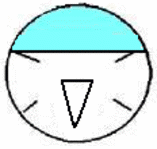
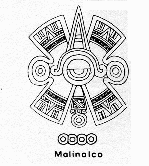
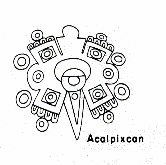
An ad hoc algorithm will move the line up or down day by day, according to the season, to maintain the synchronism with dawns and sunsets.
It’s an extremely simple mechanism which would allow us to know day by day, with just a look, everything about the movements of the sun and the hours of darkness and light. Information that today is provided only by very detailed almanacs.
The auxiliary year (tzolkin)
The clock is based on relations 1) and 2), and therefore, there is little choice on how it can be realised. The basic mechanism is a central wheel counting the hours of the day. An outer ring counts the days of the week, completing a full turn every week. The number of partitions of this ring varies according to the length of the week, selected with an ad hoc regulation. The same clock, in fact, works properly for whatever length of the week that can be changed at will.
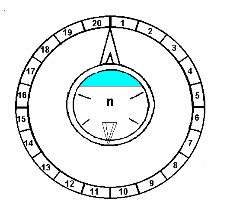
What does not change is the ring outside, divided into 20 parts, along which two hands are moving, one long and one short. The long hand counts the days and moves forward one step every solar day. The short hand counts the weeks and moves forward one notch every time the inner wheel has completed one week.
A complete revolution of the long hand equals 1 month of 20 days.
A complete revolution of the short hand equals 20 weeks of n days, that is 1 auxiliary year (T=20n).
Due to relations 1) and 2):
– the long hand completes 73 (72+1) revolutions every 4 years of 365 days.
– the short hand completes 73 (72+1) revolutions every auxiliary century, that is 4n years of 365 days.
At the end of the auxiliary century, the two hands will be aligned on the zero. At this point, in order to re-phase the calendar with the solar year, n days, that is, one week, must be added. This can be achieved in different ways, for example, by stopping the hands for one week and rotating counter-clock-wise the ring of the 20 days. The new auxiliary century, therefore, begins with both hands on box n of the ring, which becomes the new reference zero.
Notice that in this way, 20 successive auxiliary centuries would be characterised by a different initial day, and each year of the n groups of 4 years of the century would always begin with the same day. So, each one of the 20 centuries would be characterised by a different group of four days, which begins in turn every group of four years. It’s only one of the many interesting characteristics and possibilities offered by this calendar.
The same operation is repeated for 31 auxiliary centuries (of 4n solar years each). At the end of the 32nd , the mechanism will restart a new complete cycle of 32 auxiliary centuries, without the addition of the usual extra week. And so on, indefinitely. At the end of every cycle, we would have the same astronomical situation with regard to the sun.
The Counters
It is a simple mechanism which provides all the magnitudes necessary to keep under control the flow of time:
– number of hours and days
– number of months of 20 days (revolutions of the long hand )
– number of auxiliary years of 20 weeks (revolutions of the short hand)
With these elements, we can, by means of ad hoc counters, visualize all information of some interest in a calendar.
Let’s see what they could be.
First, the actual date, that is the day of the month in the solar year and the day of the auxiliary year. They could be shown at the sides of the central mechanism on four small windows, two for the solar date and two for the auxiliary date.
Then, we have to position these dates in the calendar, counting the time elapsed since the starting date. Due to the use of an auxiliary year, it becomes natural to first position the day inside the auxiliary century of 4 n auxiliary years. This inevitably is obtained by partitioning that period into smaller periods. For example, in today’s civil calendar we often add to the actual date the progressive number of the day and of the week, and we divide the year in quarters and so on.
The same divisions can be done in a much more rational way in this new calendar, descending from the relations existing inside an auxiliary cycle. An elegant division is prompted by the fact that 4 solar years contain exactly 72 + 1 months of 20 days (72 months of 20 days + 4 x 5 days). 72 can be divided in many ways, for example, by 4, 3 and 6; that is, each of the four solar years could be divided into three semesters. The counter, therefore, would show the number of the solar year in the bunch of four, then the number of the semester in the year (1-3) and finally the number of the month within the semester (1-6). Finally, there should be an indication positioning the group of four years within the auxiliary century (1, 2 …n). In this way our day is positioned precisely with respect to the solar year within the auxiliary century.
Then, we should position our day with respect to the auxiliary century; what can be done with a counter identical to the first one, due to the fact that one auxiliary century is made up of 72 + 1 auxiliary years?
The same counters can be utilised to count the number of days within a group of four years, and the number of weeks within the auxiliary cycle, since four years contain exactly 1,460 days ((72+1).5×4) and one auxiliary cycle 1,460 weeks (plus one only at the end, in order to maintain the coincidence with the sun).
Our counters would look more or less like the following.
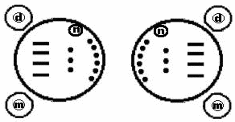
There is other information that is required from a “general purpose” calendar, that is, the precise number of days elapsed since a starting date. This information is not really useful in everyday life, but it is essential for astronomers, historians and archaeologists. The instrument in use today for this purpose was provided by the French philosopher J. Juste Scaliger, who in 1583 published the book “Opus novum de emendatione temporum”, in which he established a “universal” calendar based on the account of solar days since a particular date, which he chose to be the 1st of January – 4712 (Julian year) at midday.
This calendar is currently used by astronomers and historians to establish and compare the dates of astronomical events (like eclipses, conjunctions, etc) and historical events, comparing different calendrical systems. For example, the Thompson correlation and all the others related to the starting day of the Mayan calendar are based on Scaliger’s universal calendar.
The simplest way to count the days is through a series of registers connected to the long hand, which moves one position every day (from 1 to 20). A first register counts the complete revolutions of the hand from 1 to 18 (this number should be 20, but in this example, we follow the same system as the Mayas), which is one year of 360 days. Once completed, it starts again while giving input to the successive register, which counts from 1 to 20 years, for a total of 7.200 days. Its output goes to a third register, which counts 20 times the previous one, for a total of 144.000 days; and finally, we have a register that counts n times the content of the previous one, completing a long cycle.

The total number of days elapsed since the start of the calendar is given simply by adding the content of each of the four registers and the number indicated by the long hand.
In this way, the calendar provides a “short” count which gives the days, weeks, months and years within the auxiliary century (called by the Mayas the “calendar round”) and regulates the entire life of the society, and a “long” count which gives the total number of days elapsed since the starting date.
The “long” count would divide the calendar into n periods of 400 years (of 360 days), each of them composed of 20 groups of 20 years and so on. A date of this calendar should report the day and the month of both the solar and the auxiliary year, together with the total number of days elapsed since the starting day of the calendar. This number is provided by the content of the different counters, exactly as in the following Mayan dates:
8 . 14 . 3 . 1 . 12 1 Eb 0 Yaxkin,
8. 11. 7. 13. 5 3 Chicchan 8 Kankin
The first date identifies the 1,253,912nd day of the calendar (8 baktuns, 14 katuns, 3 tuns, 1 month and 12 days) and the actual day of the solar and the auxiliary years. The second identifies the 1,233,885th day (8×144,000 + 11×7,200 + 7×360 + 13×20 + 5) and so on.
The central mechanism of our clock-calendar would, therefore, look more or less like the following:
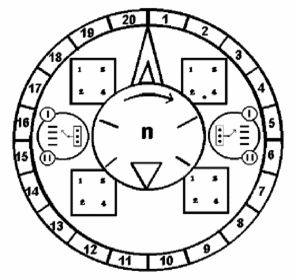
In no way is this intended to be an interpretation of the precise meaning of the corresponding counters of the Aztec calendars. It’s just an example to show what kind of information could be represented in the central mechanism of a calendar of this type and how it could be organised. Several representations of this mechanism have been found in Mexico and all of them show the same basic scheme; they should provide the same information about the solar and auxiliary years, although represented in different styles.
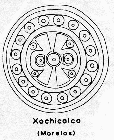
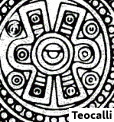
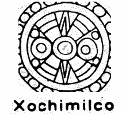
Other astronomical magnitudes of the clock-almanac
In our almanac, information that is always represented is the phase of the lunar cycle, or month, with all that is related to it, that is, solar and lunar eclipses.
Other elements are the movements of the sun in the zodiac, that is, the signs of the zodiac, the movement of the planets and their synodic years, the prevision of conjunctions, eclipses, etc. All this information should be represented in our astronomical clock so that we can have a complete vision of what is going on in the sky every day and make prevision of future astronomical phenomena.
This information can be represented on external rings and windows around the central mechanism that visualise astronomical and astrological phenomena and cycles which have a constant ratio with the solar or auxiliary years, like the position of the sun in the zodiac, the lunar cycles, the synodic years of the planets and so on. Precession, too, can be monitored through a slow shift of the zodiac.
All of these magnitudes are independent of the length of the week, which, however, is the most important element in a calendar because it has a major impact on the life of a society and determines the length of the auxiliary year and the auxiliary century (for example, a week of 8 days would determine an auxiliary year of 160 days and an auxiliary century of 32 years, instead of 260 days and 52 years for a week of 13 days).
The length of the week can be set and changed through an ad hoc regulator, so there must be on the clock a clear indication of the selected length of the week. The final aspect of our astronomical clock could, therefore, be the following.
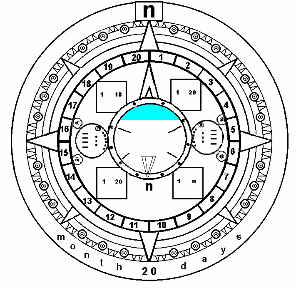
Central American calendars
The aim of this long description is not to suggest a change to the civil calendar (unthinkable today) but to demonstrate the rationale of the calendar used by Central American civilizations, Aztecs, Mayas, Toltecs, and Olmecs before them. It was a calendar based on an auxiliary year of 260 days, divided into 13 months of 20 days (or in 20 weeks of 13 days), and on a century of 52 years. The solar year was, in its turn, divided into 18 months of 20 days + 5 end days.
It is evident that this calendar belongs to the family of calendars described above. We don’t know what determined the choice of 13 as the length of the week. A likely reason could be that the auxiliary year of 260 days is well suited to keep under control some astronomical magnitudes, like, for example, the synodic year of Mars, which is exactly 260 x 3 = 780 days. The synodic year of Venus, too, 584 days, has a round ratio with the solar and auxiliary years, as 584×65=260×146=365×104 (where 65 = 260/4). As a matter of fact, the Central American civilisations placed enormous importance on the synodic year of the planets, particularly that of Venus and Mars. Another reason Venus was regarded as a very special planet could be the fact that 365/584=0,625= 80/128, which is quite an extraordinary coincidence.
A possible objection is that, according to most chronicles about that calendar (but not to all of them), there were no leap years. Most likely, they added an entire week only at the end of every auxiliary cycle, as required by this type of calendar. They had the means to establish with precision the dates of solstices, which is proven by the extremely accurate alignments and the existence of gnomons in their temples. It’s not likely that they ignored the shift of the solar year with respect to their calendar and didn’t correct it.
At the end of each auxiliary century of 52 years, there was a delay of 13 days, that is exactly one week. These 13 days, added to the final unlucky 5 days of the year, formed an additional month of 18 days (like the number of months in a solar year), which ended the cycle under the aegis of terror and death. It was the month during which, according to the traditions, the end of the world was expected. To avert this danger, the Aztec priests accomplished terrific slaughters. Thousands of prisoners were sacrificed, while the population remained barricaded in their houses, prey to terror. Those days were so inauspicious that they were never named nor accounted for: they didn’t exist. No wonder that the chronicles of that period do not mention them.
Also, the Maya called the 5 days of the additional month at the end of each year “uayeb” (nameless). However, a representation of this was never found, so it was considered non-existent. This is why the solar year was considered to be 360 days.
There have been several attempts to explain the origin of such an extraordinary calendar. But so far, nobody has succeeded in providing a likely explanation or finding out when and where it appeared for the first time. The only certitude is that it is very ancient and was used by the most ancient known civilisation of Central America. There is no trace of a gradual evolution from a more simple structure, like, for example, in the Roman calendar. It starts from the beginning in its full capacity. On the contrary, it seems that the capacity to utilize all of its initial characteristics and potentiality was gradually lost due to a loss of knowledge for various reasons.
Who originated the Central American calendars
It’s quite evident that this calendar is based on the 128-year cycle and derived from the natural unit of time, U, which is the 80,000th part of a mean solar day. We have to assume, therefore, that it was designed by the same people who originated that unit of time. People belonging to a technological civilisation advanced enough to measure the exact length of the synodic year.
Therefore, they were certainly able to make astronomical clocks of the type so far described. For some reason, this unknown civilisation has disappeared, but either directly or through survivors, it transmitted its astronomical knowledge to the populations that started the ancient known civilisations.
We have to assume that the natural unit of time, U, and the second, were used by two populations, developed in the same cradle and belonging to the same cultural horizon, who wanted to differentiate from each other by means of two different calendric and numerical systems.
Evidently, there had been immigrants or survivors, using the natural unit of time, that landed on the coasts of Central America, thus originating or influencing the civilizations of that area. They must have had with them several astronomical clocks of different complexity, from those very simple, providing only essential information in a plain way, to the most elaborated and artistic objects, with all possible astronomic information.
These objects had to be kept with the utmost care, but sooner or later, they stopped working, and most of them went rotten. Some of them, however, were regarded as sacred objects and guarded fiercely with extreme care during a span of time that lasted several millennia. They were reproduced on the most important sites of the society, like the altars of the temples and the thrones of the kings, carved on the stone. That’s why we have accurate images of them.
Probably, the carvers did not know anything about the meaning of the objects they were reproducing on the stone, and they did not understand the nature of many of the indications of the object, either because it was corroded by time or because they had never seen anything like it. In any case, we have several representations of clocks of that type, some very simple and linear, others astonishingly elaborated. All of them, however, have the same basic structure, evidence that they all reproduce objects of the same category with similar functions: clock-calendars.
The Teocally’s calendar
One of the best-kept and represented calendars is the calendar carved on a throne in the Teocally temple in Tenochtitlan. The central mechanism is quite schematic, with no representations of gods or animals. We clearly recognize the central clock, which indicates the day’s hours, divided in day and night by a horizontal line. Outside, there are two rings, one indicating the week, the other the 20 days of the month. And then, the counters and registers are organised exactly as in our example and in the large stone calendar that we’ll see later. The outer rings represent astronomical cycles that we can only guess are surely connected with the moon, planets and zodiac.
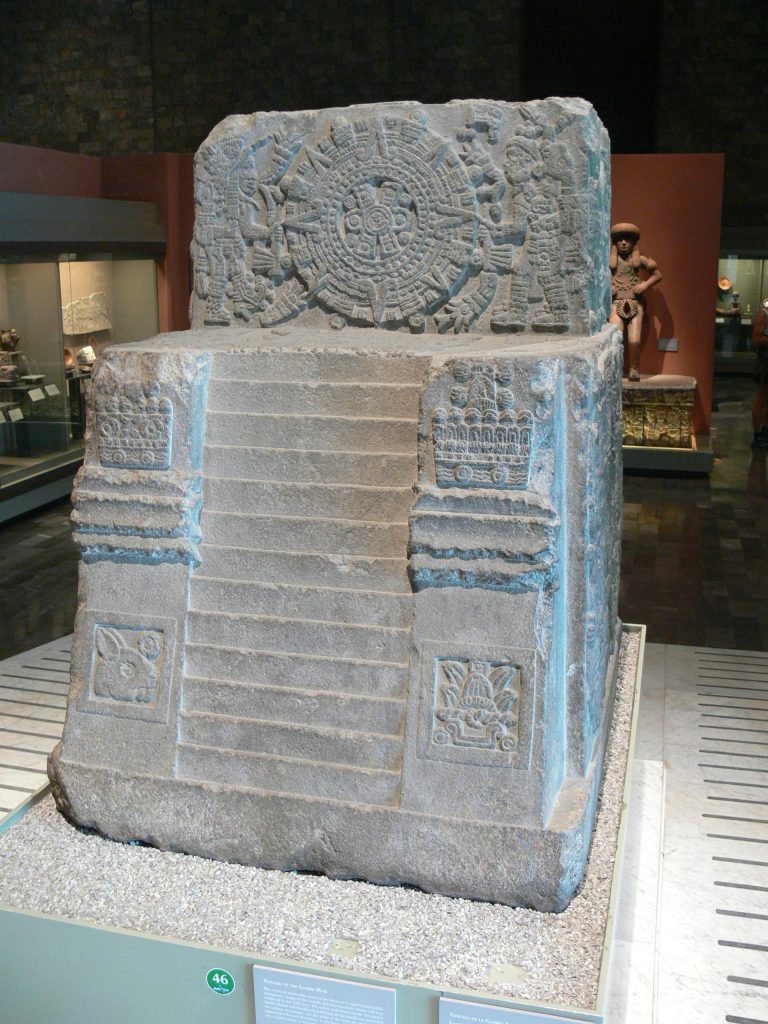
Teocalli, photo Wolfgang Sauber, (CCBYSA3.0)
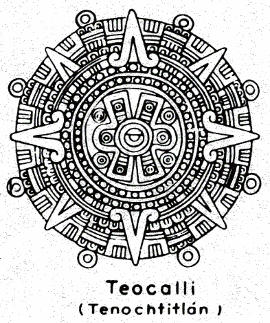
The carver who made this sculpture was copying a real object, not just representing an abstract concept.
Objects of the same kind were reproduced in several places (the essential part being the central clock with its counters).


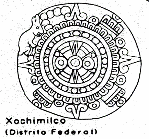

All of them present the same basic design of the central mechanism. They had to provide the same information.
The Aztec Sun Stone
The most beautiful, elaborated, complete and artistic representation of an astronomical clock was carved by the Aztecs a few years before the arrival of the Spaniards, discovered only on December 1790, buried in the “Zocalo” (the main square) of Mexico City.
It is known as the Aztec Calendar, or the Sun Stone, a huge monolith with a diameter of 12 feet, a thickness of 3 feet, and a weight of 25 tons, an amazing indication of the importance of the object that it was intended to reproduce.
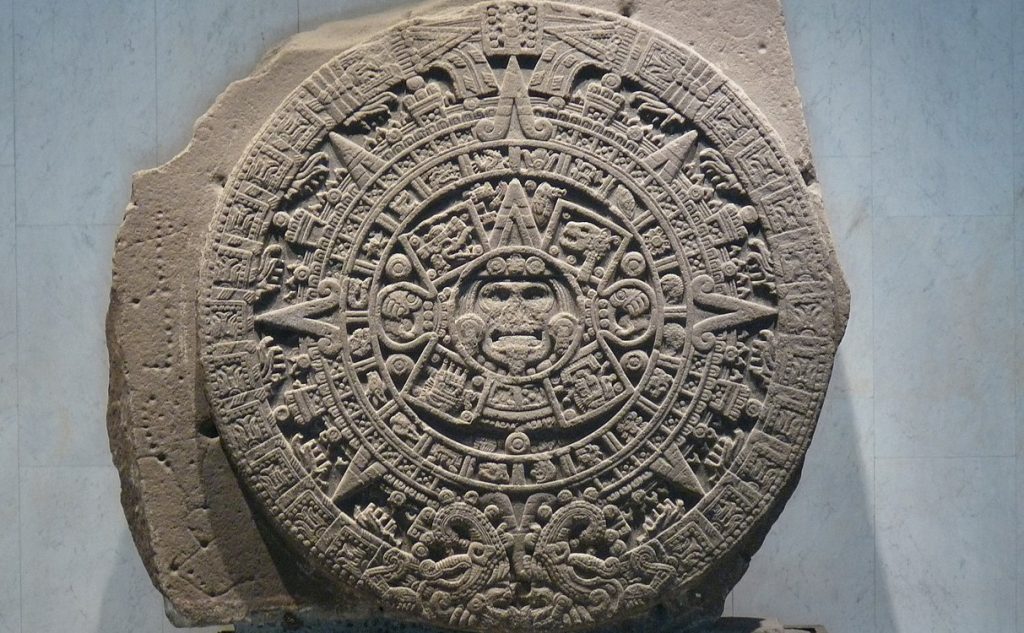
The Sun Stone, photo El Comandante, (CCBYSA3.0)
First, we note, at the top of the disk, in all evidence, the number 13 establishes the length of the week and, as a consequence, the length of the auxiliary year (called Tzolkin by the Mayas). In the middle, the mechanism of the astronomical clock, with the “god” sun right in the centre, is clearly recognisable, representing the hours of the solar day and the days of the week. Two hands, long and short, point to a first external ring, divided into 20 sections, one for each day of the month of the auxiliary year. Around the central clock there are counters and registers that show the relevant information about the actual date in the short and long count. Outside the ring with the 20 days of the month there is another ring divided into 40 rectangles, each with 5 units inside. We have, therefore, 200 units, which might represent the 200 synodic years of Mars contained in 600 auxiliary years of 260 days.
The successive ring is divided into 8 sectors, each one containing 10 divisions. It might indicate the 80,000 years of a great cycle (128 x 625), or the 80 synodic years of Venus contained in a cycle of 128 solar years or some other astronomical magnitude of some interest. For example, if we suppose that the ring represents a cycle of 1664 (32 x 52) years, each of the 80 divisions represents a period of 20,8 years, that is exactly 13 synodic years of Venus, a figure quite significant, coincident with the “scale” of this calendar.
The successive ring is divided into 32 sectors and the final one in 64, both numbers related to the 128-year cycle. Very interesting is the symbol that appears six times on the external ring, a sort of rectangle with five units inside and 3 notches on top. It might represent magnitudes related to the lunar cycles, like, for example, the 3 x 33 lunar months and 5 Venus’ years contained in 8 solar years.
Then, there are 12 animal-like figures that could represent the 12 signs of the zodiac. The final band contains 20 sections, each with 5 notches; possibly some magnitude related to the long count.
Of course, these are only wild guesses or, better, simple examples of what the information provided by the various sections of the clock could be. Most probably, even the Aztec priests could no longer understand all of its details. In any case, it is quite likely that the Aztec carver had faithfully reproduced, almost like in a picture, a real mechanical object, to the point that we could make an astronomical clock that is a perfectly functional and identical representation of the Sun Stone. All we have to do is decide what information we want to provide in its various windows and rings.
The mark of the mysterious ancient civilisation
The Sun Stone, in all likelihood, is the reproduction of a mechanical device, a sort of astronomical clock, capable of measuring the time according to a calendar based on the 128-year cycle and the natural unit of time U.
It provides additional evidence of the existence of an unknown civilisation preceding the Central American civilisations, which possessed advanced astronomical and mathematical knowledge and the technology necessary to make a mechanical device of that type.
A question then immediately arises: “Where and when did this civilisation exist?”.
Let’s assume that the “Sun Stone” really reproduces a mechanical clock. Usually, on those objects, there is a signature, a label, or a trademark, which identifies the author and/or the country where they come from. Something of this kind could be represented in the lower part of the “Sun Stone”, where there is a scene which is not functional in the mechanism of the clock and looks rather strange.
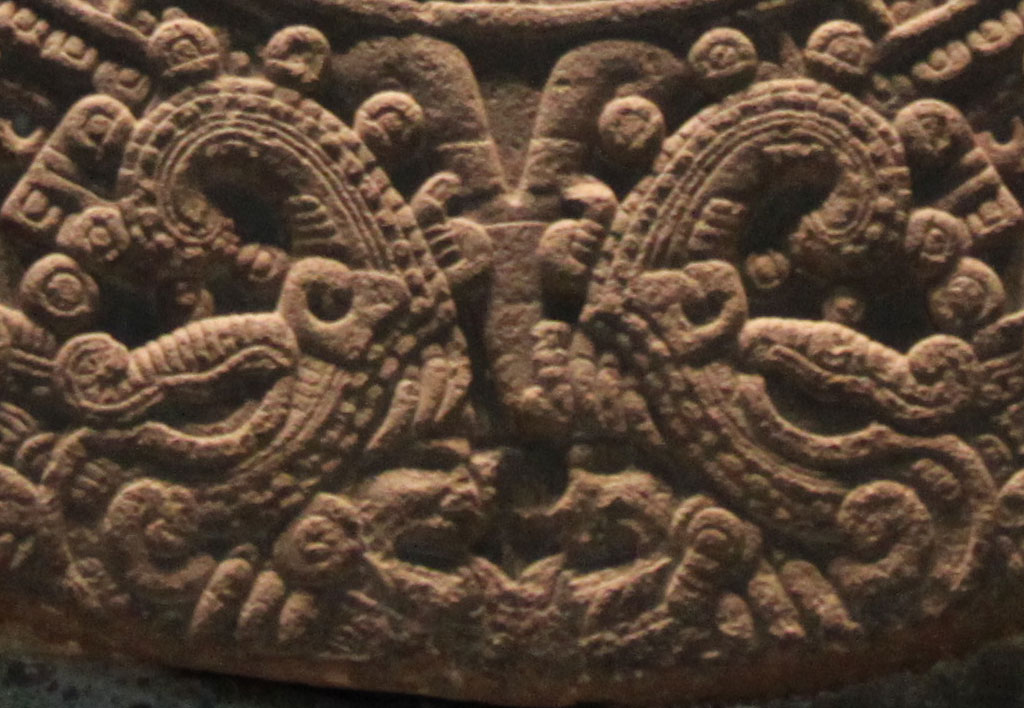
Piedra del Sol, photo Gary Todd, (CC0)
The conventional interpretation of this image is that it represents two “feathered serpents” swallowing two men. There are, however, a number of details in it that do not make sense from this perspective. It appears that the Aztec carver could not understand what was represented in the model he was copying from, and therefore, he introduced some small modifications in order to have a representation that made sense to him. If we could find out what his model looked like, we might have indications about the origin of the mechanical device represented in the Sun Stone.
We can solve the problem by examining the image piece by piece, beginning with the two human figures. If we isolate them from the rest of the representation, we obtain an image clearly defined that, in itself, makes complete sense.
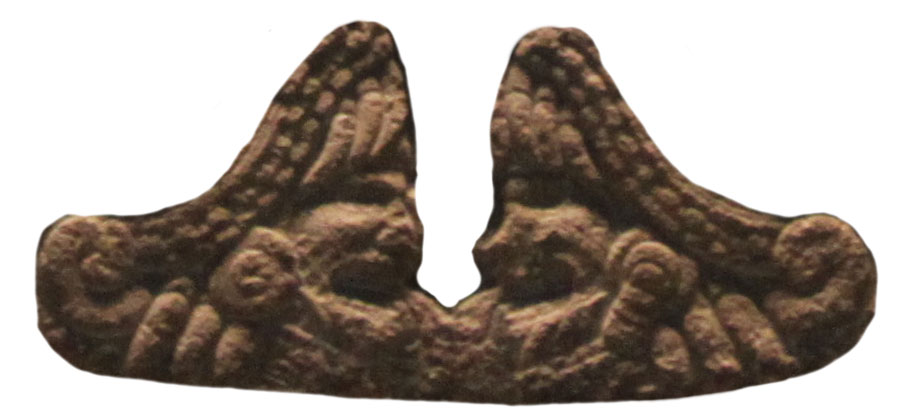
Piedra del Sol, photo Gary Todd, (CC0)
It represents two persons with some very significant properties, which characterise them as two “gods”. Their earrings, or better “ear-plates”, for instance, are a typical attribute of the “gods” through all Central America (note that even the sun-god at the centre of the stone has earrings of the same type), India, China and South East Asia. Even their “headgear” is typical of the “gods” in the same areas.
The subject is clear and consistent, and therefore, we can assume that for this part, no significant modifications, with respect to his model, have been introduced by the carver. If there are modifications, then they should have been introduced in the remaining part of the representation.
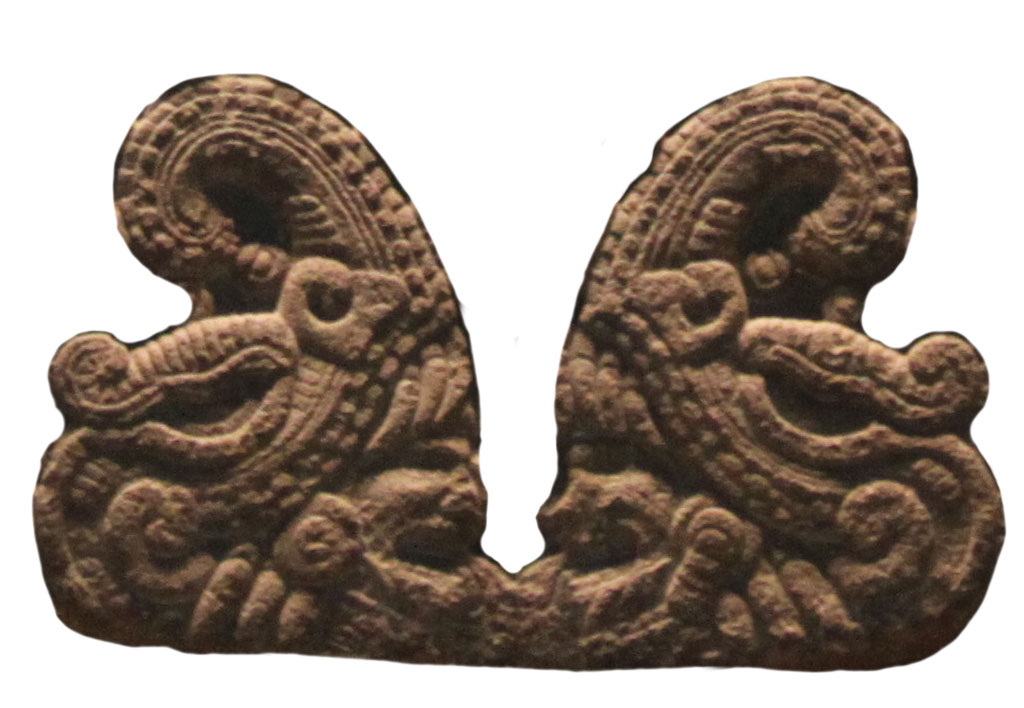
Piedra del Sol, photo Gary Todd, (CC0)
Examining the figure above, we immediately identify a first probable modification in the “hats” of the two presumed serpents. It looks likely that in the original model, they had a symmetrical shape and that one of their extremities was slightly modified in order to represent the “nostrils” of the two monsters. A second obvious modification, then, had to be done in order to give them eyes. If we reinstate the original shape of the hats and cancel the eyes, we obtain an image that should be very close to that of the original model.
The new image is clear, consistent and makes perfect sense to us. Instead of two unlikely “serpents” swallowing two men, it represents two perfectly recognisable elephants, with their trunks raised, behind two “gods”. This image, however, could not make sense to an Aztec, who did not know anything like an elephant. Therefore, he had to change a few details in his model in order to represent something that made sense to him.
Where could a “trademark” representing two gods and two elephants on the back come from? The first answer that comes to mind is Southeast Asia, India or Indo-China. The Indian civilisation had advanced knowledge in the astronomic and mathematic fields, was perfectly able to make complicated mechanical devices and produced sacred numbers that undoubtedly derive from the 128-year cycle. But we don’t have any evidence that it was able to make mechanisms of such complexity, nor that it had designed a calendar like the Central America’s, based on the natural unit of time and on a vigesimal accounting system. Besides, there is no evidence at all about prehistoric contact between India and America.
India, however, was not the only place where elephants, the type represented on the Sun Stone, existed. It’s a well-known fact, even if almost always overlooked, that elephants existed in South America until the end of the Pleistocene, about 11.500 years ago. They were not mammoths, which populated North America, Asia and Europe. They were proper elephants, similar to the Asiatic type, from which, however, scientists are keen to distinguish them by naming them “mastodons”. Nobody knows when and from where they came to South America, but their bones can be found in many places, often in relation to man, like in the famous archaeological site of Monte Verde, in Chile, whose inhabitants lived around 12.500 years ago and hunted elephants.
Elephants and mysterious ancient civilisations make South America a more likely candidate than India as the place where the Aztec calendar-clock was made. In this case, however, the date goes back prior to the end of the Pleistocene, when the elephants disappeared from South America. It’s the same epoch when, according to Plato, Atlantis existed, the land of the “gods” par excellence, which in Plato’s account was swarming with elephants, to the point that if we would imagine a mark for it, the one represented on the sun stone would look the most appropriate and evocative. It. might be that the mechanical clock reproduced on the sun stone by an unknown Aztec artist was the product of that civilisation, made with precious materials capable of lasting for the time it was intended to measure: millennia.
Atlantis could be the mysterious ancient civilisation that, for the first time, measured the length of the synodic year with almost absolute precision and established those units of time still in use today, from which calendars and numerical systems of the ancient world were derived.
References
– Agnoli, P., D’Agostini G., The Earth based units of length and the birth of the metric system,
Università “La Sapienza”, retrieved: http://www.roma1.infn.it/~dagos/history/sm/node4.
html
– Barbiero F., A Frozen Civilisation – Atlantis in Antartica, https://www.amazon.it/FROZEN-CIVILISATION-ATLANTIS-ANTARCTICA-English-ebook/dp/B08D8L8JBQ
– Barrell, H. (1961). Eleventh General Conference of Weights and Measures, Nature 189, 195–
196. https://doi.org/10.1038/189195a0
– Cartwright, M., Sep 2010, Sun Stone, Ancient History Encyclopedia.
– Caso, A. (1971), Calendrical Systems of Central Mexico. In Gordon F. Ekholm and Ignacio
Bernal (Volume eds.), Handbook of Middle American Indians, Vol. 10: Archaeology of
Northern Mesoamerica, part I. R. Wauchope (General Editor). Austin: University of Texas
Press. pp. 333–348. ISBN 978-0-292-70150-2. OCLC 277126
– Christodoulidis, D. C., Smith, D. E., Williamson, R. G., Klosko, S. M. Observed tidal braking
in the Earth/Moon/Sun system, 10 June 1988 https://doi.org/10.1029/JB093iB06p06216.
– Eremeeva, A. I. (1975). “Glazenap, Sergei Pavlovich.” In Great Soviet Encyclopaedia, vol.
6, editor-in-chief: Prokhorov A. M., 424. New York: Macmillan.
– Hapgood, C. H. (1966). Maps of the Ancient Sea Kings: Evidence of Advanced Civilization in the Ice Age; 1997. Paperback Reprint Edition, Adventures Unlimited Press, ISBN
0-932813-42-9.
– Hapgood, C. H. (1962). Piri Reis map of 1513. Paper presented at the Xth International
Congress of the History of Science, New York.
– Justeson, J. S., Kaufman T., Mesoamerican Calendars. In Davíd Carrasco (ed.) The Oxford.
Encyclopedia of Mesoamerican Cultures. Vol 1. New York: Oxford University Press,
2001. ISBN 9780195188431
– Malmström,V. H. (1973), Origin of the Mesoamerican 260-Day Calendar, Science 181.4103.
939. PMID 17835843.941
– Nuitall, Z. (1904), The periodical adjustment of the ancient Mexican calendar, New Era.
– Spedicato, E., Patten, D. W. (2001), On the numbers 54 and 108, Report Miscellanea
4/01, Bergamo University.
– Stephenson, F. R., Morrison, L. V. (1984). Long-Term Changes in the Rotation of the Earth:
700 B. C. to A. D. 1980, Philosophical Transactions of the Royal Society of London. Series
A, Mathematical and Sciences, Volume 313, Issue 1524, pp. 47-70, DOI: 10.1098/rsta.
1984.0082
– The Correspondence of Joseph Justus Scaliger, 8 vol; ed. by Paul Botley and Dirk van Miert. Genève: Droz, 2012. (Travaux d’Humanisme et Renaissance; 507) ISBN 978-2600-
01638-4
– The Mercator world map of 1569, Nova et Aucta Orbis Terrae Descriptio ad Usum Navigantium Emendate Accommodata, 1961, in the form of an atlas in the Maritime Museum “Prins Hendrik”, Amsterdam
– Thompson, J. E. S. (1960). Maya Hieroglyphic Writing: An Introduction, Civilization of
the American Indian Series, N. 56 (3rd ed.). Norman: University of Oklahoma Press.
ISBN 0-8061-0447-3. OCLC 275252.
– Thompson, J. E. S., “Maya chronology: The correlation question” (PDF). mesoweb.com.
Retrieved: 6 September 2015.
1 We should remind that the cycle of 128 years was discovered by the Russian astronomer Glasenapp at the end of the 19th century, when the technological and scientific progress allowed to measure the length of the year with a precision up to the fourth decimal. He proposed to revise the Gregorian calendar accordingly, but without success
2 The present civilian calendar, inherited by the Romans and fixed by pope Gregory XIII in 1582, is definitely not the most rational and even less the most precise of possible calendars. It only takes about 3,300 years for this calendar to accumulate a difference of one day with respect to the solar year. This time-span could be increased to 80,000 years if we adopted a calendar based on a cycle of 128 years, as it was proposed by the Russian astronomer Glasenapp at the end of the 19th century






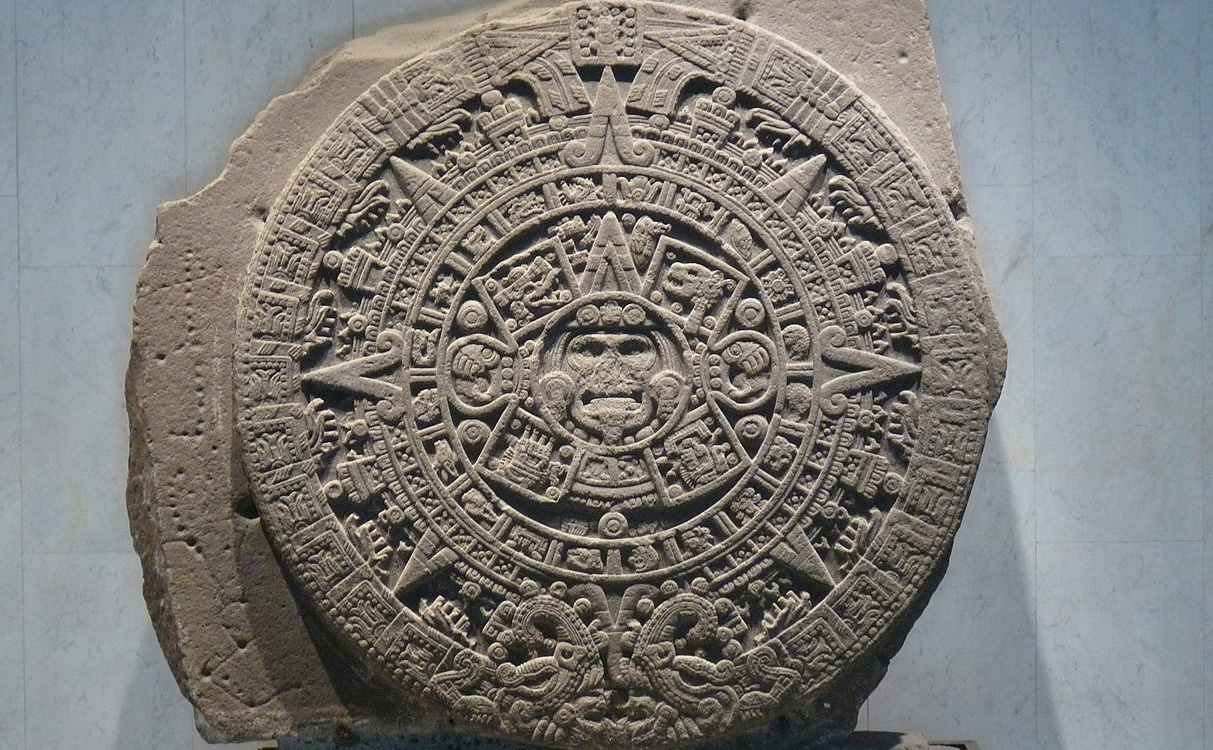
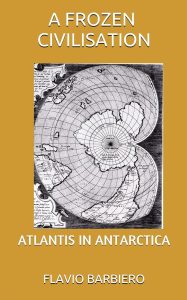
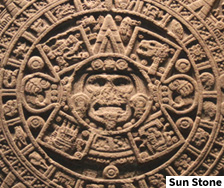
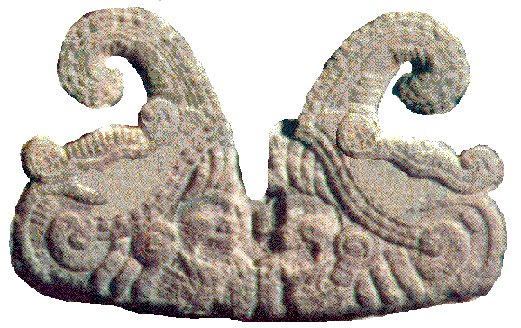
fascinating and intriguing thank you
Very interesting.
Thank you for your work